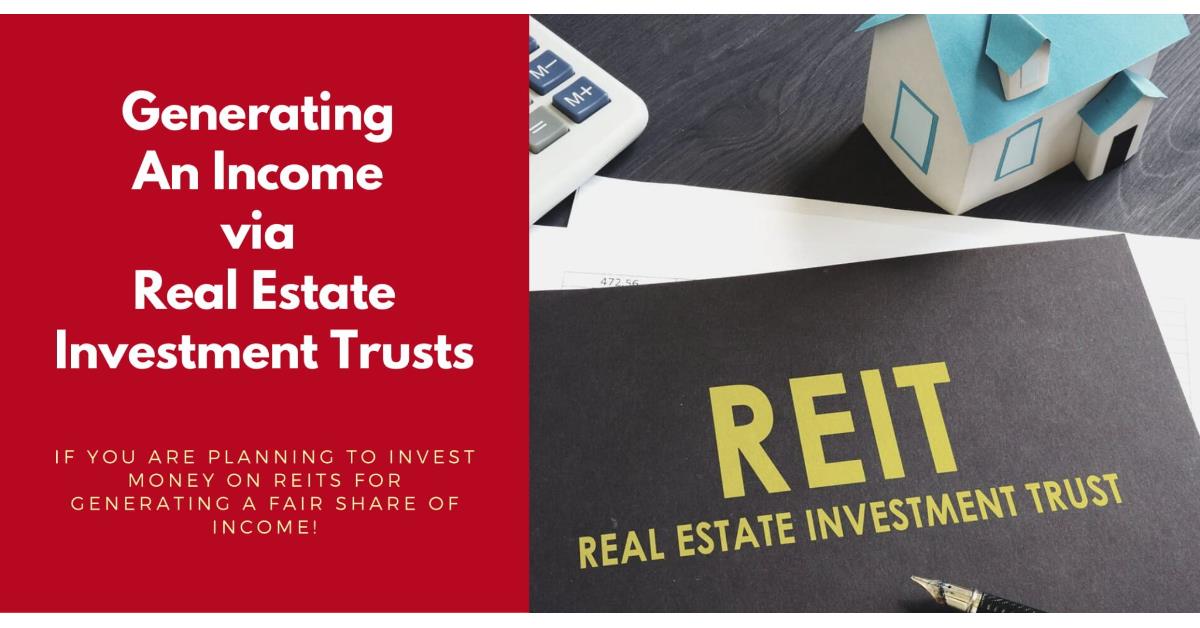How do REITs work, and how to make money investing in REITs, Real Estate Investment Trusts?
REITs own or finance income-generating real estate. Investors pool capital to purchase a portfolio of buildings. REIT collects rent and distributes income to investors through dividends. It's a low-risk way to generate returns.last updated Tuesday, February 18, 2025
#how do reits work #how to make money investing in reits
| | John Burson | Subscribe |

QUICK LINKS
AD
Get access to EB 5 Visa Investment Projects
In the ever-changing world of investments, Real Estate Investment Trusts (REITs) have become a popular avenue for both novice and seasoned investors looking to diversify their portfolios with real estate without having to directly own property.
REITs provide a way to invest in large-scale, income-generating real estate, such as office buildings, shopping centers, hotels, and even data centers, while offering liquidity and low barriers to entry.
This blog will break down the fundamentals of REITs, how they work, how to make money investing in them, and key things to consider before diving into this investment strategy. We will also discuss the two primary types of REITs—Equity REITs and Mortgage REITs—and how they generate returns for their investors.
What Are REITs?
A Real Estate Investment Trust (REIT) is a company that owns or finances income-producing real estate. These entities pool capital from multiple investors to purchase, manage, or finance real estate, and in return, they distribute the income generated from rents and mortgage payments back to shareholders as dividends.
The unique appeal of REITs lies in their structure. They offer regular dividends from the rental income of commercial or residential properties and allow investors to invest in real estate markets without directly owning property themselves. These investments are highly liquid, as they can be traded like stocks on major exchanges such as the NYSE.
How Do REITs Work?
REITs are designed to provide a steady income stream, typically in the form of dividends, as well as capital appreciation over time. To qualify as a REIT, a company must adhere to several specific guidelines:
- Structure: A REIT must be a corporation under the IRS Revenue Code.
- Management: It must be managed by a board of directors.
- Asset Investment: A REIT must invest at least 75% of its total assets in real estate, cash, or government securities.
- Dividend Payout: REITs must distribute at least 90% of their taxable income to shareholders in the form of dividends. This helps avoid corporate tax payments, as income is taxed at the shareholder level.
- Shareholder Requirement: At least 100 shareholders must own shares in the REIT.
These regulations ensure that REITs primarily focus on real estate investment, pass on income to shareholders, and remain structured in a way that benefits investors.
Types of REITs
There are two primary types of REITs: Equity REITs and Mortgage REITs (mREITs). Each has its own approach to generating returns for investors.
Equity REITs
Equity REITs are the most common type of REIT and primarily own, operate, and manage income-generating real estate. Their portfolios often include a range of property types, such as:
- Office buildings
- Apartment complexes
- Shopping malls
- Industrial facilities
- Healthcare facilities
- Hotels and resorts
Equity REITs generate income through the rents they collect from tenants. This income is then distributed to shareholders in the form of dividends. The value of these REITs also tends to appreciate over time as the real estate market improves, which can increase the value of the REIT's holdings.
Equity REITs can be further divided into different categories, based on the specific type of real estate they focus on:
- Lodging and Resort REITs: Invest in hotels and resorts.
- Self-Storage REITs: Focus on storage units and self-storage facilities.
- Data Center REITs: Invest in data centers that store information for tech companies.
- Infrastructure REITs: Own infrastructure such as cell towers, energy pipelines, or fiber-optic networks.
- Industrial REITs: Own warehouses and distribution centers used for e-commerce and logistics.
- Timberland REITs: Invest in forested lands and timberland properties.
Mortgage REITs (mREITs)
Mortgage REITs do not own properties directly. Instead, they finance real estate by investing in mortgage loans or mortgage-backed securities (MBS). These REITs earn income from the interest payments on the loans or bonds they hold.
mREITs can be categorized into two types:
- Agency mREITs: These REITs invest in government-backed mortgages, such as those issued by Fannie Mae or Freddie Mac.
- Non-Agency mREITs: These REITs invest in private-label mortgage securities that are not backed by government entities.
Mortgage REITs tend to be more volatile than equity REITs because they are highly sensitive to interest rate changes. They often use leverage (borrowed money) to purchase more mortgage-backed securities, which can amplify both returns and risks.
How do reits make money ?
Investing in REITs can provide two primary forms of returns: dividends and capital appreciation.
- Dividends
REITs are required by law to distribute at least 90% of their taxable income to shareholders in the form of dividends. This makes REITs an attractive option for income-seeking investors. The dividend yield for REITs can vary, with some offering higher-than-average returns compared to traditional stocks or bonds. - Capital Appreciation
In addition to dividends, REITs can increase in value as the properties they own or finance appreciate over time. Equity REITs, in particular, can benefit from rising real estate prices, increasing the value of their holdings and driving share price growth.
However, it’s important to note that not all REITs are created equal. Higher dividend yields may sound attractive, but they can also signal financial instability in the company. REITs with higher yields may be facing challenges, and their ability to sustain dividends could be at risk. Therefore, it’s crucial to carefully evaluate the financial health and growth prospects of a REIT before investing.
Choosing a REIT for Investment
When choosing a REIT, consider the following factors:
- Cash Flow Profile
Look for REITs with consistent cash flow and a track record of paying reliable dividends. - Valuation
Evaluate the REIT’s price-to-net asset value (P-NAV). A positive P-NAV suggests the REIT is overpriced, while a negative P-NAV might indicate an undervalued REIT. - Dividend Yield
Compare the REIT’s dividend yield to those of other investment options, such as bonds or stocks. - Location and Property Type
Consider the geographical areas and property types that the REIT invests in, as these can impact rental income and capital appreciation. - Interest Rates
Mortgage REITs are particularly sensitive to changes in interest rates, so it’s important to monitor interest rate trends when investing in them.
How Much Should You Invest in REITs?
There is no one-size-fits-all answer when it comes to how much of your portfolio should be allocated to REITs. However, a good starting point is typically around 5% to 10% of your overall portfolio. Some experts suggest that REIT exposure can range from 5% to 20%, depending on an investor’s risk tolerance and investment goals.
Frequently Asked Questions
Is investing in REITs profitable?
Yes, REITs are typically profitable for investors. They offer regular dividend payouts, which are attractive to income-focused investors, and they can also provide long-term capital appreciation.
How do I buy REITs?
You can buy REITs through stock exchanges just like other stocks. Many investors choose to purchase shares of REITs via ETFs or mutual funds for broader diversification.
Are REITs risk-free?
No, REITs come with risks. Market fluctuations, interest rate changes, and real estate downturns can affect the value of REITs. It’s essential to research and choose REITs wisely.
What is the difference between an equity REIT and a mortgage REIT?
Equity REITs own and manage physical real estate, while mortgage REITs invest in mortgages and mortgage-backed securities.
How do interest rates impact REITs?
Higher interest rates can hurt REITs, especially mortgage REITs, by increasing borrowing costs and potentially reducing property values. Equity REITs may also see slower growth in a higher interest rate environment.
Conclusion
Investing in Real Estate Investment Trusts (REITs) provides a compelling opportunity for those looking to diversify their portfolios and gain exposure to the real estate market. With the potential for attractive dividends and capital appreciation, REITs offer a relatively low barrier to entry and can fit a variety of investment strategies. However, as with any investment, thorough research and understanding of the specific REIT type you’re investing in is essential to minimize risks and maximize returns.
By following the right guidelines and considering factors like cash flow, market conditions, and interest rate trends, investors can navigate the REIT landscape and create a profitable investment portfolio.
Free Consultation
Similar Pages
- Paperfree | Alternative investments platform: real estate investments, private equity, eb5 investment visa USA & more to build wealth, preserve wealt

- The Process of hard money lending

- 5 Common Mistakes to Avoid When Investing in Real Estate

- How to find Flaws Fix and Flip Properties Will Hide

- Are You Paying Too Much for a Real Estate Investment Property?

- The Lender Checklist: Finding a Solid Real Estate Investment

- 3 Types of Bad Credit Commercial Hard Money Lenders

- Real Estate Investment Principles by Bruce Flatt the CEO of Brookfield Asset Management

Popular
Benefits of the EB-5 Visa Program | Guide
Search within Paperfree.com
